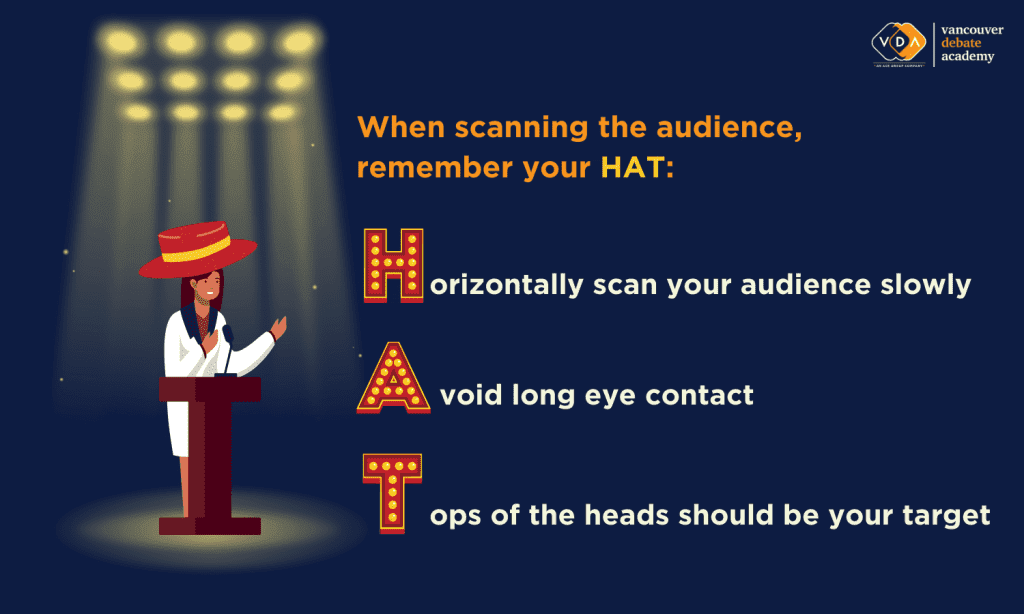5 Tips for Overcoming Speech Anxiety

You’re about to go on stage to speak before a huge audience. Your palms are sweaty, knees are shaking, and the butterflies in your stomach are fluttering at max speed. How will you ever make it through the presentation without throwing up?!
If only you had read some tips for calming down beforehand. At the end of the day, speech anxiety is a problem because it prevents the audience from receiving our message, either because our anxiety causes us to forget parts of the presentation or because our anxious habits can cause distractions and barriers to audience reception.
Here are five key strategies for reducing anxiety and improving audience reception.
1. Plan Ahead
This is a no-brainer, but it really is the best first step. If you are giving a speech or presentation that is planned, the most effective way to reduce anxiety is to avoid procrastination.
Once you know the date and time of the event, figure out how much time you have to prepare. Break your process into parts, from planning and writing, all the way to execution and practice.
When you break this process down over time, it increases the amount of time you spend familiarizing yourself with the content, making you more comfortable. When you procrastinate, it is way more challenging to deliver your content and increases anxiety in the long term.
2. Make Condensed Notes
Creating a speech is a process that starts with brainstorming something small, like a topic, and then expanding it to something much larger, like a ten-minute presentation. Sometimes, when we get close to presentation day, we get tunnel vision and suddenly, everything you prepared is flying through your head and you can’t even remember your hook.
Stop, take a deep breath, and condense your speech. Find a notecard — doesn’t matter what size — and write the following things on your notecard:
- Your hook. What opening line is going to catch the audience’s attention and introduce them to your topic?
- Your first point. Think of one word that best describes the subject of your first main point. Write that on your card before adding 2-3 word point-format notes on any details you’d like to discuss under that point.
- Repeat step 2 with the remaining main points.
- Add your clincher to the bottom. How will you tie everything together with any questions or ideas you posed in the introduction?

3. Practice in the Mirror
Practicing in front of others is the best option, but sometimes our anxiety is so overwhelming that the thought of showing anyone our speech might make matters worse!
Presenting a speech to yourself can not only give you the much needed practice, but it will also force you to listen to yourself speak and look at how you present.
Repeat your speech as many times as needed until you feel comfortable with how you sound delivering it. Recording yourself giving the speech is also a great way to rehearse, and you can play the video back to fine tune specific parts!
4. Audience Scanning
Have you ever looked at someone for too long during a presentation? Eye contact can be a tricky thing, especially when you’re looking at a large crowd.
One of the best pieces of advice a teacher can offer is to scan the audience. Don’t ever look anyone directly in the eyes for more than half a second. Move your gaze over the heads of the audience, but don’t ever stop at one point for too long.
The goal of audience scanning is to avoid the awkward gaze that could throw you off during your speech. You never want to have a moment in your speech where you get lost in someone’s eyes and forget your next point!
When scanning the audience, remember your HAT:

5. Curl Your Toes
Sometimes anxiety can even affect our bodies in strange ways, like making us rock back and forth, or tense up like a board while speaking.
Curling your toes in your shoes is an easy fix that stops this body language in its tracks. Curling your toes causes you to stop the movement in your feet, relaxes the body, and grounds you in one place.
If you find you are a fidgety speaker, find ways to ground your movement, like keeping your hands by your sides when you are not gesturing. Minimizing visual signs that you are anxious improves the overall reception of the speech and boosts your confidence!
About Us
Vancouver Debate Academy is a leading private institution in Canada focusing on Speech and Debate coaching for Grade 3 to Grade 12 students.
VDA’s mission is to train students to think critically about their world and advocate successfully for themselves and their communities.
Through the collective efforts of our expert coaches, talented students, and experienced team, VDA students have broken several debate records in Canada in the past five years. Learn more about our achievements here.
Start your speech and debate journey with VDA today! Learn more about our program: Grade 4-7; Grade 8-12.






